Pav Bhaji:-
If you want to buy pav bhaji from street shops in Mumbai then this post is only for you. I have broken down this recipe into basic simple steps that anyone can make at home. So feel free to give it a try.
About Pav Bhaji:-
Our dearest Mumbai has given us some kind of road food and pav bhaji is totally one of them. Simply, “pav” means bread; It is a delicate dinner roll that you will find in all pastry kitchens across India. “Bhaji” is a spicy pounded squash vegetable curry served with buttered pav and together they bring an amazing flavor that you cannot ignore.
It is so easy to make that you can take it out anytime. Making it at home also guarantees that you have all the hygiene in place which can be a trial in some high street shops.
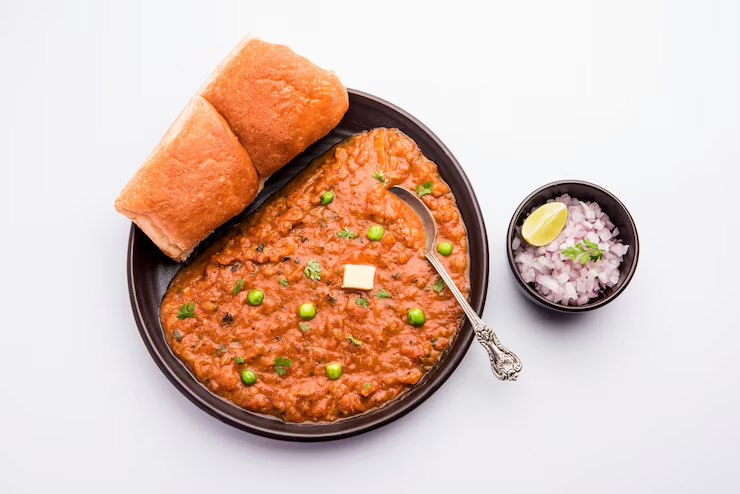
Material:-
Vegetables – These vegetables are the primary element of Bhaji. The choice and quantity of vegetables has a big impact on how your bhaji will taste. Interestingly, I recommend following my recipe. If you feel something is missing, just make changes and let me know what changes you made so I can try them too.
I used vegetables that are easily available in the market including cauliflower, cabbage, potatoes, green chillies (capsicum), carrots and green peas.
Similarly, you will also need red onion, green chilli and tomato. Change the chillies as per your taste.
To make this recipe, you must hack the vegetables. I used my vegetable chopper to chop them, however you can use a sharp blade to finely chop them on your cutting board.
Pav Bhaji Masala – The basic flavor of this dish comes from a zesty mixture called Pav Bhaji Masala. I make it at home, though you can also get it from Indian supermarkets near you. If you want to adopt a home recipe then this is the way to make pav bhaji masala.
Spread – Margarine makes this dish rich and delicious and you will need a ton of it to make it taste like the street food traders.
Other Ingredients – You will also need some more basic storage ingredients like ginger-garlic gum, Kashmiri red bean stew powder, paneer, lemon juice, salt and cilantro (fresh coriander leaves).
The most effective method of making pav bhaji:-
cook vegetables
We’ll start by cooking the chopped vegetables. Add the vegetables to your strain cooker with 1 cup of water and mix well.
1 and 1/2 cups cauliflower florets
1 and 1/2 cup chopped cabbage
1 and 1/2 cups chopped green ringer pepper (capsicum)
1 and 1/2 cup chopped carrots
1 cup green peas
1 cup peeled and chopped potatoes
Secure the top of the strain cooker and tension cook for 3 whistles on your oven on high intensity.
Remove the pressure of the cooker and allow the strain to release normally.
Open the top of your cooker.
make vegetables
As I mentioned earlier, we will be using a large amount of margarine to bring out that legitimate flavor. Heat 6 tablespoons of plain salt in a pan over medium-high heat.
Now add 1 and 1/2 cups chopped red onion and cook, stirring regularly with your spoon, until clear.
Add 4 tbsp ginger-garlic paste and cook them until the onions turn light brown and the raw smell of ginger and garlic goes away.
Now add 2 spoons of chopped green chillies, 2 cups of chopped tomatoes and ½ cup of water and cook for 2-3 minutes.
Now it’s time to add your spices. Add 2 tsp Kashmiri red stew powder and 5 tbsp pav bhaji masala and cook for a while while mixing continuously with your scoop.
Add the cooked vegetables to your container and mix everything well with a spoon.
Now crush the bhaji using a potato masher until it becomes soft. Crushing vegetables will require some muscle work, but it will still be worth the effort.
Reduce the intensity of your oven and cook for 10-12 minutes. Considering that the bhaji seems thick, add more water. It should be of pourable consistency.
Finally, add ½ cup grated cheese, 1 tablespoon lemon juice, 1 teaspoon salt and 2 tablespoons coriander to your bhaji and mix well.
Check for salt and lemon squeeze and add more as desired if necessary.
Serve bhaji hot with new buttered pav.
Bhindi Bhaji (Maharashtrian Style Okra Vegetable):-
Bhindi Bhaji (Bhindi Chi Bhaji) is Maharashtrian style ladyfinger pan seared. This vegetable-loving and gluten-free side dish comes together in less than 30 minutes and is really simple and easy to make (vegan, gluten-free).
About Bhindi Bhaji:-
Bhindi Bhaji (Bhindi Chi Bhaji) is a traditional Maharashtrian style Bhindi Pan Seared. This simple and straightforward Indian dry vegetable recipe (sabzi) is made by sauteing bhindi with garlic, onion, tomato and some regular flavor powder.
Bhindi Bhaji is an incredible dish to make for a regular Indian dinner and is best served with dal and phulka or dal rice. Like Maharashtrian Aloo Bhaji, this is also a good dish to pack in the lunch box.
Bhindi is prepared in many ways in India, although this Maharashtrian style is my new favorite.
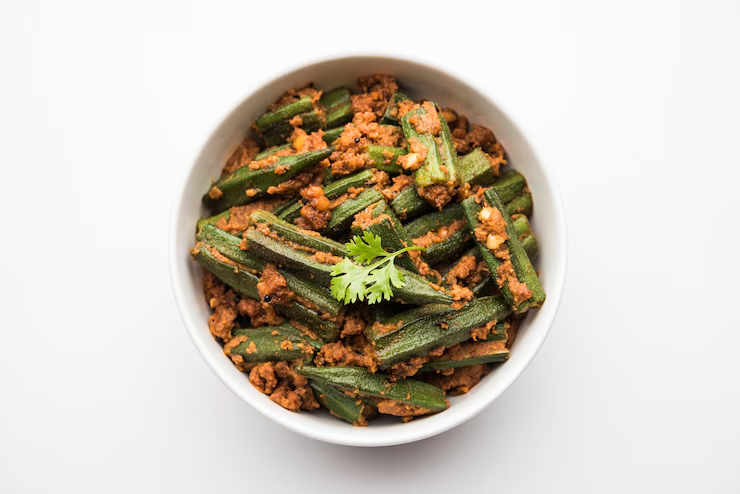
Material:-
Bhindi (okra, lady finger) – Buy delicate, long, crisp looking, pale green bhindi. Try not to buy items with flaws or cuts.
You can also include frozen ladyfinger instead of fresh ladyfinger to make bhaji. Defrost it and spread it out on a paper towel for 30 minutes to get rid of any moisture that has formed due to ice formation. Then, use it in recipes.
Oil – You can use any oil for cooking.
Flavoring Powder – This recipe uses some basic Indian flavorings, for example, coriander powder, turmeric powder, Kashmiri red bean stew powder, and garam masala powder.
Others – To make this Maharashtrian style bhindi sabzi, you will also need earthy colored mustard seeds, cumin seeds, garlic, red onion, tomatoes, salt and cilantro (fresh coriander leaves).
Instructions to make Bhindi Bhaji:-
Wash 1 pound (500 g) of okra and pat each dry with a kitchen towel or paper tissue. Remove 0.5 pieces of top and base and cut bhindi into 0.5 inch pieces.
Heat 2 tablespoons oil in a vessel on high flame.
Add the chopped okra to the dish and fry on high intensity for 4-5 minutes, stirring frequently.
Roasting the bhindi before mixing it with the different ingredients will ensure that it does not spoil later.
Once the ladyfinger is cooked, take it out in a plate.
Add 2 tablespoons of oil to a similar dish and heat on high.
When the oil becomes hot, add 1 teaspoon earth-coloured mustard and 1 teaspoon cumin seeds and let it cook for 3-4 seconds.
Add 2 teaspoons chopped garlic and 1 cup chopped red onion and cook on medium intensity until they turn light brown (6-8 minutes), stirring most of the time.
Add ½ cup chopped tomatoes and cook for 3-4 minutes.
1 teaspoon salt
2 teaspoon coriander powder
1 teaspoon turmeric powder
2 teaspoons Kashmiri red stew powder
½ tsp garam masala powder
What’s more, cook for 10-20 seconds.
Add the roasted bhindi back to the container and mix well with the spices.
Reduce the intensity to a minimum.
Cover the container from top and cook till the bhindi becomes soft (8-10 minutes). Mix once or twice while cooking.
Remove the cover. Add 2 tbsp coriander and mix well.
Check the salt and add more if necessary.
Bhindi Bhaji is ready to serve.
Batata Vada :-
Batata Vada is a famous Indian dish from the state of Maharashtra. It is made by covering hot potato mixture and then frying it until cooked. To make it tasty at lunch time, serve it with green chutney and dry garlic chutney.
About Batata Vada Recipe:-
Batata = potato (potato) and vada = deep cooked garbage. Batata Vada (Potato Vada) is a traditional Maharashtrian style dish, where spicy potato mixture is covered with a batter of chickpea flour (besan) and cooked to glorious perfection.
Making Batata Vada at home is very simple and takes less than 30 minutes. The taste of this Aloo Vada varies from region to region and from home to home. In the present post, I am sharing the recipe which I got from my mother. It is a constant hit among my loved ones and is really easy to make.
Batata Vada is best enjoyed during the rainy season with green chutney, dry garlic chutney and some fried salty green bean stew chilli. You can also serve it at lunch time. The equivalent vada is filled between the pav (buns), and is popularly known as vada pav.
This delicious thing can be made delicious by frying it in Paniyaram dish without any oil. This will give you crispy batata vada with almost less calories. As another option, you can heat the vadas and fry them in air.
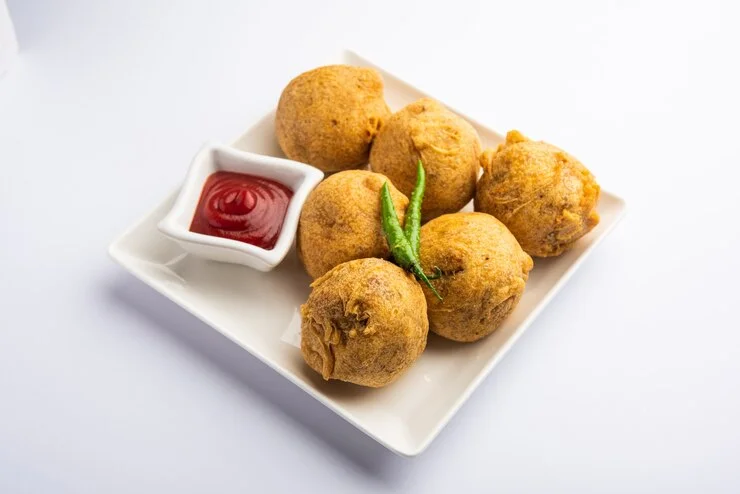
Material:-
To make the heater for the outer cover, you will need gram flour (besan), celery, cornstarch, salt, vegetable oil, turmeric powder and baking pops. The thickness of the player is very important, it should neither be too thick nor too watery.
The mixture of turmeric powder and baking soda is also important to get the right color and consistency of the vada. I used standard cup and spoon allotments to measure the fixings.
to make the stuffing
There is a delicious potato masala in the form of my Aloo Vada, where boiled, peeled and mashed potatoes are mixed with asafoetida, crushed coriander seeds, cumin seeds, cashew nuts, raisins, green bean stew chilli, coriander (coriander), salt, red Is mixed with stew. powder, dry mango powder, ground black pepper, garam masala powder, and cooked cumin powder.
Red stew powder can be replaced with paprika powder or cayenne.
You can add some shredded cheddar to the masala to give the vadas that nasty sticky taste.
Use any vegetable oil to fry these vadas.
Instructions to make Batata Vada:-
cook potatoes
Start by cooking 400 grams of potatoes. You can boil them in a traditional tension cooker, Moment Pot, or in a pot over a burner. Unlike aloo tikki where you want cold dried potatoes, use freshly boiled potatoes to make the filling of batata vada.
Try not to overheat the potatoes. They should be somewhat firm and not soft.
This is the way to cook potatoes for stuffing.
Traditional Strain Cooker – Wash the potatoes with water and put them in a tension cooker. Cover with water and close the top. Pressure cook on medium flame till 5-6 whistles. Remove the pressure of the cooker and allow the strain to release normally. Open the top and run the potatoes under cold water. Use it as a bandage.
Moment Pot – Wash the potatoes and put them in the Moment Pot with 1 cup of water. Close the cover and set the valve to fix. Press Strain Cook and set the clock on high tension for 6v minutes. When the clock stops, allow the tension to dissipate normally for 10 minutes. Physically remove excess tension and open the top. Run the potatoes under cold water. Use it as a bandage.
Skillet over burner – Wash the potatoes and peel them using a vegetable peeler. Cut into 1-inch blocks. Take a pot of water to a spinning bubbler at high intensity. Add solid shapes of potatoes and reduce the intensity. Cook for 15-20 minutes until soft. Channel and run under cold water. Squash and use.
make the stuffing
When the potatoes cool down, we should make the filling. Heat 2 tablespoons vegetable oil in a skillet over high heat.
When the oil becomes hot, add ¼ teaspoon asafoetida, 1 teaspoon crushed coriander and 1 teaspoon cumin and let it crackle for 4-5 seconds.
Add 1 tablespoon crushed cashews and 1 tablespoon chopped raisins and sauté until they caramelize (8-10 seconds).
2 tsp finely chopped green stew chillies, 2 tbsp coriander (coriander), crushed boiled potatoes, salt to taste, 1 tsp red stew powder (or red chilli), 1 tsp dried mango powder, ½ tsp ground black pepper, Add ½ tsp garam. masala powder, and ½ tsp cumin powder andCook on medium intensity for 4-5 minutes. Remove the heat from the dish and let the filling cool completely.
Make small lime sized balls from the filling and keep aside. You can also flatten the ball to some extent so that it is not difficult to fill the vada in the pan while making vada pav.
Create player for outer shell
In a medium-sized bowl, whisk together 1 cup chickpea flour, ½ cup cornstarch, 1 teaspoon oregano, 1 teaspoon salt, 1 tablespoon vegetable oil, ½ teaspoon turmeric powder and 2 squeezes of baking soda.
Slowly add water (about ⅓ cup) and make a knot free streaming player.
Searing Batata Vada
I like to fry the vada twice for extra strength. I fry them one at a time on medium-high intensity until they are nicely caramelized. – Then take them out in a plate. Then fry again on high intensity until well cooked and firm. Do try this method for more solid vadas.
Heat oil in a deep plate or pan on medium-high intensity to fry well.
Put the potato balls in the heater and wrap them well with the pliers. Drop them slowly into hot oil. Use a fork to dip and remove them from the heater. Try not to fill the dish with stuff.
Fry the vadas on medium-high intensity until they turn light brown. Use an open spoon to keep turning them to cook them evenly on all sides.
Place the channel on a plate lined with a paper towel. Fry all the vadas until cooked well and take them out in a plate.
Now once again heat the oil on high intensity until it becomes extremely hot. Once again drop some vadas in hot oil and fry them till they are nicely browned and fresh.
Place them on a plate lined with paper towel.
Urdachi Dal (Maharashtrian Style Urad Dal):-
Uradchi Dal (Maharashtrian Style Urad Dal) is a Maharashtrian dal prepared with dark colored urad dal. Make it using my simple recipe.
About Urdachi Dal:-
Uradchi Dal (Maharashtra style urad dal) is a light and delicious dal dish made with dark urad dal, green chillies, onions and young ginger. Spicy onion, tomato and green bean stew seasoned with cooked lentils. This is an extraordinary recipe to make for typical Indian-style feasts. Serve it with dry vegetables and phulka or boiled rice and papad for evening meal.

Material:-
to cook lentils
1 cup black urad dal
2 teaspoons chopped green chillies
2 teaspoon chopped ginger
¼ cup chopped onion
¼ teaspoon turmeric powder
1 teaspoon salt
1 spoon ghee
4 cups water
for tempering
2 tbsp peanut oil (or any other cooking oil)
2 tbsp ghee
1 teaspoon cumin
¼ teaspoon asafoetida
10-12 whole curry leaves
¼ cup chopped onion
2 teaspoons crushed green chilli, ginger and garlic
½ cup finely chopped tomatoes
1 teaspoon Kashmiri red chili powder
1 teaspoon coriander powder
Instructions to make Urdachi Dal:-
Add all the ingredients to the pressure cooker and stir gently.
Pressure cook on high flame till 1 whistle.
Then reduce the flame and cook for 15 minutes.
Remove the cooker from the flame and let the pressure release on its own.
Open the lid and lid and mash the dal lightly with the back of the ladle.
temper the lentils
Heat oil and ghee in a small pan over medium-high heat.
When the oil is hot, add cumin and asafoetida and fry for 4-5 seconds.
Add curry leaves, onion and crushed green chillies, ginger and garlic and fry for 2 minutes.
Now add tomatoes and fry for 2 minutes.
Add chilli powder and coriander powder and fry for 3-4 seconds.
Pour the tadka over the cooked dal and mix well.
serve hot.
Kolhapuri Egg Curry:-
Kolhapuri Egg Curry (Anda Rassa) is a hot egg curry made by cooking hard-boiled eggs in a delicious onion-coconut based sauce. Try my traditional recipe to make this.
About Kolhapuri Egg Curry (Anda Rassa):-
Kolhapuri Egg Curry, commonly known as Anda Rassa, is a flavourful and delicious egg curry from Kolhapur, a city in western Maharashtra.
The use of freshly ground masala gond gives the egg rasa a unique flavor and sets it apart from other egg curries.
This hot and thin curry goes best with bhakri, yet you can also serve it with phulka or steamed rice.
This recipe is gluten-free, and you can of course double or triple it.
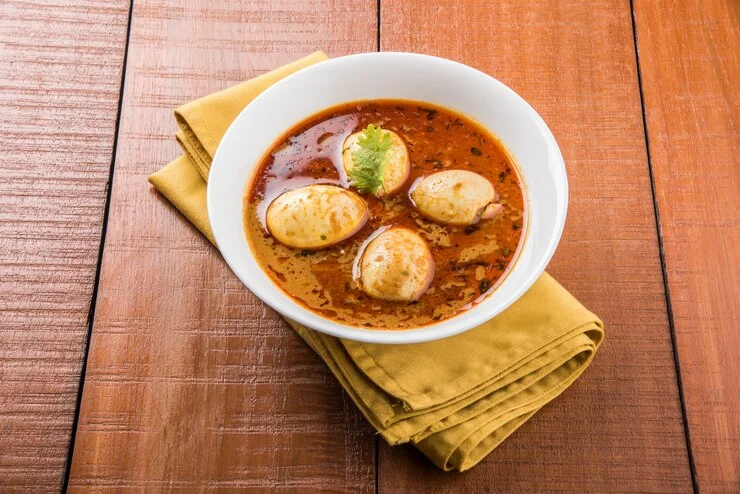
Material:-
to fry eggs
You will need hard-boiled eggs, oil, turmeric powder and Kashmiri red bean stew powder.
You can heat the eggs on a burner, in another pot, or in an air fryer. Check out my Air Fryer Hard Bubbled Eggs recipe for amazing bubbled eggs.
To make Masala Gum
The freshly ground masala gond makes this curry exceptionally extraordinary.
Wholesome Flavors – You will need some wholesome flavors like cloves, cinnamon, black cardamom, black pepper, coriander seeds and cumin seeds.
Others – You will also need desiccated coconut, green chillies, white sesame seeds (till), cilantro (fresh coriander leaves), and fresh tomatoes.
Change the green chillies as per your choice.
for curry
To make curry, you will need oil, cumin, onion, Kashmiri red bean stew powder, kanda lasun masala, turmeric powder and salt.
Kanda lasun masala is a traditional Maharashtrian masala that adds an extraordinary flavor to curries. It is easily available in Indian supermarkets or on the web.
Instructions to make Kolhapuri Egg Curry:-
Beat 6 eggs, grate desiccated coconut and chop onion, tomato, green chilli and coriander. Until it hardens. Take them off and wipe them with a paper towel.
boil eggs
Using a sharp blade, make 3-4 cuts in the boiled egg.
Heat 1 tablespoon oil in a pot on medium heat
Add ¼ teaspoon turmeric powder and ¼ teaspoon Kashmiri red stew powder and sauté for 2-3 seconds.
Put eggs in the container and fry for 3-4 minutes and take them out in a plate. Keep turning the eggs while frying them so that they fry evenly from all sides.
Make Masala Gum
Add the accompanying ingredients to a pan and cook on medium heat until the dish is somewhat browned and fragrant (4-5 minutes). Mix as usual.
1 cup grated dry coconut
6-8 cloves
1 inch stick of cinnamon
1 black cardamom
4-5 black peppers
1 teaspoon cumin
1 tablespoon coriander seeds
1 tablespoon white sesame seeds
Remove the dish from the heat and let the mixture cool for 8-10 minutes.
Place the boiled ingredients, along with the ingredients provided, into a blender.
2 teaspoons chopped green chillies
2 tbsp chopped coriander
½ cup chopped tomatoes
Add ½ cup water and mix to make a smooth paste.
make curry
Heat 4 tablespoons oil in a pot over medium-high heat.
When the oil is hot, add 1 teaspoon cumin seeds and fry for 4-5 seconds.
Add ½ cup chopped onion and cook until golden brown. Mix regularly while boiling.
Add ground masala and cook for 3-4 minutes. If the masala seems too much then add a little water.
Now add the above ingredients and cook for 3-4 minutes.
2 teaspoons Kashmiri red bean stew powder
2 tsp kanda lasun masala
½ tsp turmeric powder
Add the given ingredients to the pan and cook for 4-5 minutes.
boiled egg
2 cups water
1 teaspoon salt
Check the salt and add more salt whenever required.
serve hot.
Katachi Amti:-
Katachi Amti is a spicy and tangy Maharashtrian dal prepared with chana dal (Bengal gram), desiccated coconut, tamarind mash, jaggery and some flavourings. This delicious tadka dal is famously served with puran poli.
About Katachi Amti:-
Katachi Aamti is a light Maharashtrian dal recipe prepared with chana dal, jaggery, tamarind and freshly grated coconut gum. It is spicy, hot, somewhat sweet and full of extraordinary flavour.
Generally, the excess water from cooking chana dal for puran poli is used to make katachi aamti, while the cooked chana dal is used to make the stuffing of puran poli.
This Katchi Amti recipe can also be made if you cook chana dal to make chana dal kebab, chana dal sundal, chana dal paratha, or pheri. I also make this whenever I cook chana dal to make the stuffing for my aloo tikki recipe.
It is served with Puran Poli, especially during Maharashtrian festivals like Ganesh Chaturthi and Gudi Padwa. You can also serve it with plain boiled rice for an invigorating weekday feast.
I cooked the lentils in my 3-quart Moment Pot (or 3-liter tension cooker). To scale the recipe, use a 6-quart Moment Pot (or 5-6 liter tension cooker). Cooking time will continue as before.
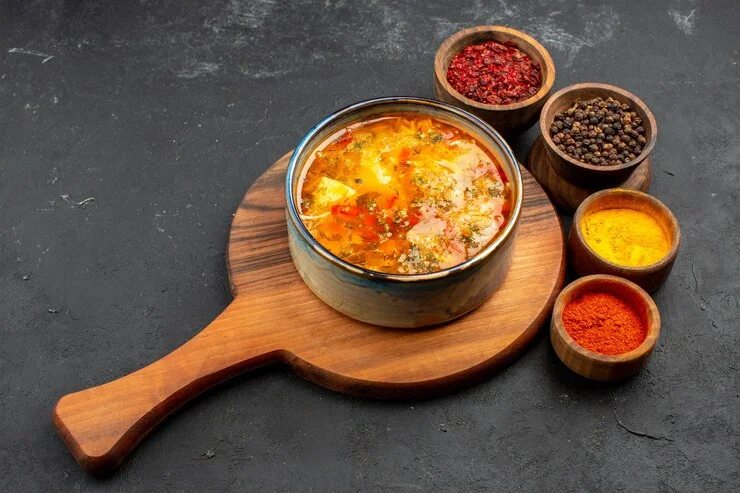
Material:-
for lentil water
To make dal water, you will need chana dal, water, salt, tamarind mash, jaggery and cilantro.
for ground glue
Freshly ground gum is made from dried coconut, white sesame, cinnamon, green cardamom, cloves and black pepper.
You can also take new coconut instead of dry coconut.
To treat Amti, you will need vegetable oil, earthy-coloured mustard, cumin, curry leaves, asafoetida, turmeric powder and Kashmiri red stew powder.
To make it gluten-free, avoid adding asafoetida to it.
To make Katachi Amti more delicious, you can also add onion to it.
To make it more delicious, add a little garam masala to it.
Instructions to make Katachi Amti:-
cook lentils
Wash 1 cup chana dal with water 2-3 times and soak it in 4-5 cups water for 30 minutes.
When the lentils get wet, drain the water and put the peeled lentils in another vessel.
Add 3 cups of water and close the lid of the vessel.
Press Tension Cook and set the clock on High Tension for 15 minutes.
When the clock stops, allow the tension to dissipate normally for 10 minutes.
Physically release any remaining tension and open the lid of the other vessel.
Strain the cooked dal through a fine strainer and save the remaining stock to make Katachi Aamti. Use cooked lentils to make Puran Poli.
make ground glue
Put the accompanying ingredients in a pan and cook the dish on medium intensity until well caramelized, stirring constantly.
1 tablespoon grated dry coconut
1 teaspoon white sesame seeds
1 inch piece of cinnamon stick
2 whole green cardamoms
2-3 cloves
2-3 black peppers
Remove the container from the heat and let the roasted ingredients cool slightly.
Add the roasted ingredients to a blender container with ¼ cup of water and blend to make a smooth paste.
make amti
Add the chana dal stock and ground masala gum to a container and heat on medium-high intensity until boiling, stirring regularly.
Add the following ingredients and mix well.
Mash 2 teaspoons tamarind
2 teaspoons ground jaggery
1 teaspoon salt
½ tsp Kashmiri Red Bean Stew Powder
½ tsp turmeric powder
Reduce intensity and cook for 5-6 minutes, stirring once or twice.
If you like thin Amti then add some water to it and heat it once till it boils.
temper the amati
Heat 1 tablespoon oil in a skillet over medium-high heat.
When the oil is hot, add the accompanying ingredients and let them crackle for 4-5 seconds.
½ teaspoon clay-colored mustard seeds
½ tsp cumin
10-12 curry leaves
¼ teaspoon asafoetida
Pour the treat over the amti and mix well.
Garnish with chopped coriander and serve hot with puran poli or boiled rice.



